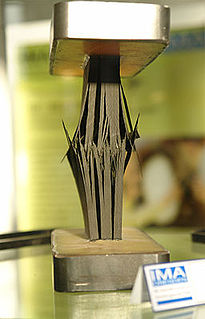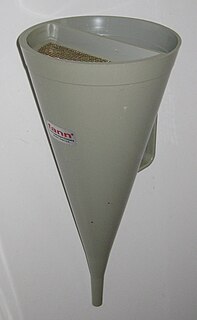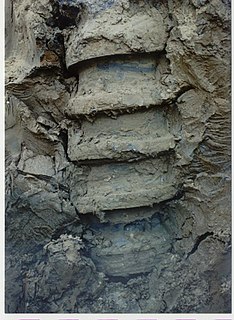Related Research Articles

Geotechnical engineering is the branch of civil engineering concerned with the engineering behavior of earth materials. It uses the principles of soil mechanics and rock mechanics for the solution of its respective engineering problems. It also relies on knowledge of geology, hydrology, geophysics, and other related sciences. Geotechnical (rock) engineering is a subdiscipline of geological engineering.

Rebar, known when massed as reinforcing steel or reinforcement steel, is a steel bar used as a tension device in reinforced concrete and reinforced masonry structures to strengthen and aid the concrete under tension. Concrete is strong under compression, but has weak tensile strength. Rebar significantly increases the tensile strength of the structure. Rebar's surface features a continuous series of ribs, lugs or indentations to promote a better bond with the concrete and reduce the risk of slippage.

Nondestructive testing (NDT) is any of a wide group of analysis techniques used in science and technology industry to evaluate the properties of a material, component or system without causing damage. The terms nondestructive examination (NDE), nondestructive inspection (NDI), and nondestructive evaluation (NDE) are also commonly used to describe this technology. Because NDT does not permanently alter the article being inspected, it is a highly valuable technique that can save both money and time in product evaluation, troubleshooting, and research. The six most frequently used NDT methods are eddy-current, magnetic-particle, liquid penetrant, radiographic, ultrasonic, and visual testing. NDT is commonly used in forensic engineering, mechanical engineering, petroleum engineering, electrical engineering, civil engineering, systems engineering, aeronautical engineering, medicine, and art. Innovations in the field of nondestructive testing have had a profound impact on medical imaging, including on echocardiography, medical ultrasonography, and digital radiography.

In engineering, a foundation is the element of a structure which connects it to the ground, transferring loads from the structure to the ground. Foundations are generally considered either shallow or deep. Foundation engineering is the application of soil mechanics and rock mechanics in the design of foundation elements of structures.
In construction or renovation, underpinning is the process of strengthening the foundation of an existing building or other structure. Underpinning may be necessary for a variety of reasons:

A heat sealer is a machine used to seal products, packaging, and other thermoplastic materials using heat. This can be with uniform thermoplastic monolayers or with materials having several layers, at least one being thermoplastic. Heat sealing can join two similar materials together or can join dissimilar materials, one of which has a thermoplastic layer.

Waterproofing is the process of making an object or structure waterproof or water-resistant so that it remains relatively unaffected by water or resisting the ingress of water under specified conditions. Such items may be used in wet environments or underwater to specified depths.

Delamination is a mode of failure where a material fractures into layers. A variety of materials including laminate composites and concrete can fail by delamination. Processing can create layers in materials such as steel formed by rolling and plastics and metals from 3D printing which can fail from layer separation. Also, surface coatings such as paints and films can delaminate from the coated substrate.

Geotechnical investigations are performed by geotechnical engineers or engineering geologists to obtain information on the physical properties of soil earthworks and foundations for proposed structures and for repair of distress to earthworks and structures caused by subsurface conditions. This type of investigation is called a site investigation. Additionally, geotechnical investigations are also used to measure the thermal resistivity of soils or backfill materials required for underground transmission lines, oil and gas pipelines, radioactive waste disposal, and solar thermal storage facilities. A geotechnical investigation will include surface exploration and subsurface exploration of a site. Sometimes, geophysical methods are used to obtain data about sites. Subsurface exploration usually involves soil sampling and laboratory tests of the soil samples retrieved.
Fiber-reinforced concrete or fibre-reinforced concrete (FRC) is concrete containing fibrous material which increases its structural integrity. It contains short discrete fibers that are uniformly distributed and randomly oriented. Fibers include steel fibers, glass fibers, synthetic fibers and natural fibers – each of which lend varying properties to the concrete. In addition, the character of fiber-reinforced concrete changes with varying concretes, fiber materials, geometries, distribution, orientation, and densities.

A deep foundation is a type of foundation that transfers building loads to the earth farther down from the surface than a shallow foundation does to a subsurface layer or a range of depths. A pile or piling is a vertical structural element of a deep foundation, driven or drilled deep into the ground at the building site.
A pile is a slender element cast in the ground or driven into it. Since pile construction as well as the final product are mostly invisible, engineers have often questioned their integrity, i.e. their compliance with project drawings and specifications. In fact, experience has shown that in piles, of all kinds flaws may occur. The purpose of integrity testing is to discover such flaws before they can cause any damage.
Dynamic load testing is a method to assess a pile's bearing capacity by applying a dynamic load to the pile head while recording acceleration and strain on the pile head. Dynamic load testing is a high strain dynamic test which can be applied after pile installation for concrete piles. For steel or timber piles, dynamic load testing can be done during installation or after installation.
High strain dynamic testing is a method of testing deep foundations to obtain information about their capacity and integrity, and in some cases, to monitor their installation. It is codified by ASTM D4945-12 - Standard Test Method for High-Strain Dynamic Testing of Piles.

The Marsh funnel is a simple device for measuring viscosity by observing the time it takes a known volume of liquid to flow from a cone through a short tube. It is standardized for use by mud engineers to check the quality of drilling mud. Other cones with different geometries and orifice arrangements are called flow cones, but have the same operating principle.

The Franki piling system is a method used to drive expanded base cast-in-situ concrete (Franki) piles. It was developed by Belgian Engineer Edgard Frankignoul in 1909.

An ultrasonic pulse velocity (UPV) test is an in-situ, nondestructive test to check the quality of concrete and natural rocks. In this test, the strength and quality of concrete or rock is assessed by measuring the velocity of an ultrasonic pulse passing through a concrete structure or natural rock formation.
Thermal Integrity Profiling is a non-destructive testing method of evaluating the integrity of concrete foundations. It is standardized by ASTM D7949 - Standard Test Methods for Thermal Integrity Profiling of Concrete Deep Foundations.

An Olivier pile is a drilled displacement pile:. This is an underground deep foundation pile made of concrete or reinforced concrete with a screw-shaped shaft which is performed without soil removal.
References
- ↑ Hadjuk, Edward L.; Ledford, D.L.; Christopher, W.R. (2004). "PVC and Steel Access Tube Debonding during Sonic Logging Testing for the SC 170 Bridge Replacement Project". Proceedings of the Deep Foundation Institute 2004 Annual Conference, Vancouver, BC.
- 1 2 Schmauder, Gretchen; Steve D. Bowman; Thomas J. Adams (2006). "CROSSHOLE SONIC LOGGING: INSIGHTS ON TESTING NEVADA INFRASTRUCTUR" (PDF). Archived from the original (PDF) on 2011-08-10.
{{cite journal}}: Cite journal requires|journal=(help)
- Farouz, E., Landers, P., Webster, S., November, 2005. Case History: Foundation Evacuation for the Virginia Highway 288 Project. GEO3 Construction Quality Assurance/Quality Control Technical Conference: Dallas/Ft. Worth, TX; 49-60.
- Beim, J.W., Debas, L.F., Kormann, A.C.M., Martinati, L.R., Neto, L.A., November, 2005. Tomography: A New Technology for Quality Control of Deep Foundations. GEO3 Construction Quality Assurance/Quality Control Technical Conference: Dallas/Ft. Worth, TX; 323-328.
- ASTM D6760 - 14 Standard Test Method for Integrity Testing of Concrete Deep Foundations by Ultrasonic Crosshole Testing, doi:10.1520/D6760-14
- ASTM D4428 / D4428M - 07 Standard Test Methods for Crosshole Seismic Testing, doi:10.1520/D4428_D4428M-07